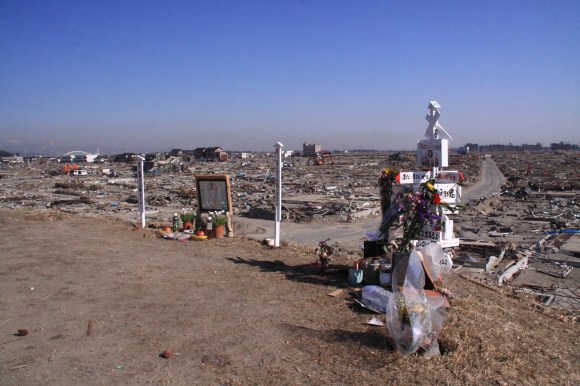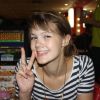
What happens after we die? Is it possible to communicate with loved ones after they are gone? And if not, how can we explain the stories of those who claim to have done so? These questions are pertinent to the work of journalist Shuji Okuno, who researches the yūrei banashi, or ghost stories, of relatives bereaved by the 2011 Tohoku earthquake and tsunami.
Over 18,000 people were killed in the disaster in March 2011, most by drowning; including 2,601 bodies that were never recovered. Okuno has been researching and recording the stories of Tohoku people bereaved by the disaster who say they were visited by the spirits of their deceased family members, often at the exact moment of their passing.
But reporting on ghost sightings in a disaster zone is controversial work. In an interview with Tohoku-area newspaper Kahoku Shimpo this week, Okuno spoke about the stories he has uncovered and the criticism he continues to face.
The journalist and non-fiction writer told the Kahoku Shimpo that he began to research these kind of ghost stories after hearing the accounts of doctors in Natori, a city in Miyagi Prefecture affected by the disaster:
“I heard that there were many people in the disaster zone who had seen spirits. Some doctors said 20 percent of their patients saw them [the spirits or ghosts of dead relatives]. I felt that this was a special phenomenon.”
Asked what kind of stories he has heard, Okuno tells the story of a woman who had lost her much-loved husband in the tsunami. Suffering from severe depression after his death, she had become suicidal, until one day, she saw a vision of her husband, and began to believe that he was watching over her. She became filled with new determination, he says, and decided to live.
There were many other stories like this, according to Okuno: people who gained the strength to live after seeing their loved one’s ghost.
In recording these stories, for which there can be no concrete evidence, Okuno has been condemned as “unscientific”; and he is not the only outlet to be criticised for giving airtime to supernatural stories about the Tohoku disaster. In 2013, NHK broadcast the TV special Nakihito to no “saikai” – hisaichi sandome no natsu ni (‘”Reunions” with the deceased – the [Tohoku] disaster area three summers on’), which told the stories of bereaved family members who say they saw their relatives’ spirits.
These included one woman who felt the presence of her son, killed in the disaster at three years old, playing next to her; she said one of his musical toys started to move on its own. The show also featured an interview with a man who had lost two sons, who saw them both appear before him, and said he heard his older son speak to him. National broadcaster NHK was criticised for the broadcast, which was condemned as an “occult show,” although others applauded the programme, saying it was sensitively made.
For Okuno, the question of whether we believe in ghosts or not is beside the point:
“[It’s not about] whether ghosts are real or not. I tried to accept people’s accounts for what they were, and to tell the stories of those who died, and those left behind.”
He argues that when we encounter things that we can’t explain scientifically, we tend to condemn them “as delusion or fantasy, or we treat them as [mental] health problems.”
Even if these visions are essentially tricks of the mind, Okuno says he has yet to encounter a single negative story, and that his research suggests a “reunion” with a lost loved one is overwhelmingly a positive experience. He stresses the importance of maintaining an open mind: “As long as these ghostly experiences aren’t having any negative effects, I think it’s fine. I want to create an environment where people can talk freely about it.”
Sources: Kahoku Shimpo, Naver Matome, Reisei shinka no michi, NHK, Live Science
Featured image: Wikipedia/ChiefHira

 Japanese Americans tell STORIES FROM TOHOKU
Japanese Americans tell STORIES FROM TOHOKU Man reported missing after 2011 Tohoku earthquake found alive and well
Man reported missing after 2011 Tohoku earthquake found alive and well NTT wants you to remember the Tohoku Earthquake by remembering the phone numbers of loved ones
NTT wants you to remember the Tohoku Earthquake by remembering the phone numbers of loved ones Tsunami Survivors Share Their Stories: Resurrecting Otsuchi, Japan
Tsunami Survivors Share Their Stories: Resurrecting Otsuchi, Japan Japanese beef bowl chain Sukiya’s 2026 Smile Box lucky bag basically pays for itself
Japanese beef bowl chain Sukiya’s 2026 Smile Box lucky bag basically pays for itself Japanese airlines offer discounted fares to international tourists
Japanese airlines offer discounted fares to international tourists Starbucks Japan ready to get Year of the Horse started with adorable drinkware and plushies【Pics】
Starbucks Japan ready to get Year of the Horse started with adorable drinkware and plushies【Pics】 Japan Airlines is giving away free domestic flights to international tourists
Japan Airlines is giving away free domestic flights to international tourists 7 great places to see Mt. Fuji from without having to climb it
7 great places to see Mt. Fuji from without having to climb it Serpentine Winnie the Pooh Year of the Snake plushies, Mickey and Baymax daruma arrive in Japan
Serpentine Winnie the Pooh Year of the Snake plushies, Mickey and Baymax daruma arrive in Japan We go behind the scenes at Japan Airlines’ in-flight meal factory【Photos】
We go behind the scenes at Japan Airlines’ in-flight meal factory【Photos】 Here are the top ten foodie factory tours for the fall throughout Japan
Here are the top ten foodie factory tours for the fall throughout Japan “Deflowering” services for virgin women are now a thing in Japan, apparently
“Deflowering” services for virgin women are now a thing in Japan, apparently Haunted hospital near Mt Fuji re-opens after renovation at Fuji-Q Highland, and it’s terrifying
Haunted hospital near Mt Fuji re-opens after renovation at Fuji-Q Highland, and it’s terrifying Cyberpunk anime meets traditional culture in Ghost in the Shell gold leaf Japanese changing screens
Cyberpunk anime meets traditional culture in Ghost in the Shell gold leaf Japanese changing screens Hayao Miyazaki says Happy New Year to Studio Ghibli fans with new art for Year of the Horse
Hayao Miyazaki says Happy New Year to Studio Ghibli fans with new art for Year of the Horse Hello Kitty Choco Egg figures are an adorable trip through three periods of Japanese pop culture【Pics】
Hello Kitty Choco Egg figures are an adorable trip through three periods of Japanese pop culture【Pics】 We found possibly the quietest Japanese-style hotel in Tokyo’s bustling Shinjuku district
We found possibly the quietest Japanese-style hotel in Tokyo’s bustling Shinjuku district 7-Eleven Japan’s ramen-cooking robot whipped us up a bowl of noodles【Taste test】
7-Eleven Japan’s ramen-cooking robot whipped us up a bowl of noodles【Taste test】 Sumo Sanrio! Hello Kitty and pals team up with Japan Sumo Association for new merch【Pics】
Sumo Sanrio! Hello Kitty and pals team up with Japan Sumo Association for new merch【Pics】 Japan’s oldest largetooth sawfish in captivity back on display in Mie Prefecture
Japan’s oldest largetooth sawfish in captivity back on display in Mie Prefecture More Than a Capsule Stay: Why Solo Travelers Choose “global cabin Yokohama Chinatown”
More Than a Capsule Stay: Why Solo Travelers Choose “global cabin Yokohama Chinatown” 7-Eleven Japan starts new temporary luggage storage service in over 300 branches
7-Eleven Japan starts new temporary luggage storage service in over 300 branches Disillusionment at Tsukiji’s tourist-target prices led us to a great ramen restaurant in Tokyo
Disillusionment at Tsukiji’s tourist-target prices led us to a great ramen restaurant in Tokyo Starbucks teams up with 166-year-old Kyoto doll maker for Year of the Horse decorations【Photos】
Starbucks teams up with 166-year-old Kyoto doll maker for Year of the Horse decorations【Photos】 Tokyo considering law requiring more trash cans following litter increase in heavily touristed area
Tokyo considering law requiring more trash cans following litter increase in heavily touristed area Tokyo’s Tsukiji sushi neighborhood asks tour groups to stay away for the rest of the month
Tokyo’s Tsukiji sushi neighborhood asks tour groups to stay away for the rest of the month Tokyo event lets you travel back in time, for free, to celebrate 100 years since Showa era start
Tokyo event lets you travel back in time, for free, to celebrate 100 years since Showa era start Sanrio theme park in Japan announces plans to expand into a Sanrio resort
Sanrio theme park in Japan announces plans to expand into a Sanrio resort Japan may add Japanese language proficiency, lifestyle classes to permanent foreign resident requirements
Japan may add Japanese language proficiency, lifestyle classes to permanent foreign resident requirements Stamina-destroying “Paralysis Noodles” are Tokyo’s newest over-the-top ramen innovation
Stamina-destroying “Paralysis Noodles” are Tokyo’s newest over-the-top ramen innovation Survey asks foreign tourists what bothered them in Japan, more than half gave same answer
Survey asks foreign tourists what bothered them in Japan, more than half gave same answer Japan’s human washing machines will go on sale to general public, demos to be held in Tokyo
Japan’s human washing machines will go on sale to general public, demos to be held in Tokyo Japan’s deadliest food claims more victims, but why do people keep eating it for New Year’s?
Japan’s deadliest food claims more victims, but why do people keep eating it for New Year’s? We deeply regret going into this tunnel on our walk in the mountains of Japan
We deeply regret going into this tunnel on our walk in the mountains of Japan Studio Ghibli releases Kodama forest spirits from Princess Mononoke to light up your home
Studio Ghibli releases Kodama forest spirits from Princess Mononoke to light up your home Major Japanese hotel chain says reservations via overseas booking sites may not be valid
Major Japanese hotel chain says reservations via overseas booking sites may not be valid Put sesame oil in your coffee? Japanese maker says it’s the best way to start your day【Taste test】
Put sesame oil in your coffee? Japanese maker says it’s the best way to start your day【Taste test】 No more using real katana for tourism activities, Japan’s National Police Agency says
No more using real katana for tourism activities, Japan’s National Police Agency says Starbucks Japan reveals new sakura drinkware collection, inspired by evening cherry blossoms
Starbucks Japan reveals new sakura drinkware collection, inspired by evening cherry blossoms Updated cherry blossom forecast shows extra-long sakura season for Japan this year
Updated cherry blossom forecast shows extra-long sakura season for Japan this year Town destroyed by 2011 earthquake and tsunami creates anime based on stories of residents
Town destroyed by 2011 earthquake and tsunami creates anime based on stories of residents
Leave a Reply